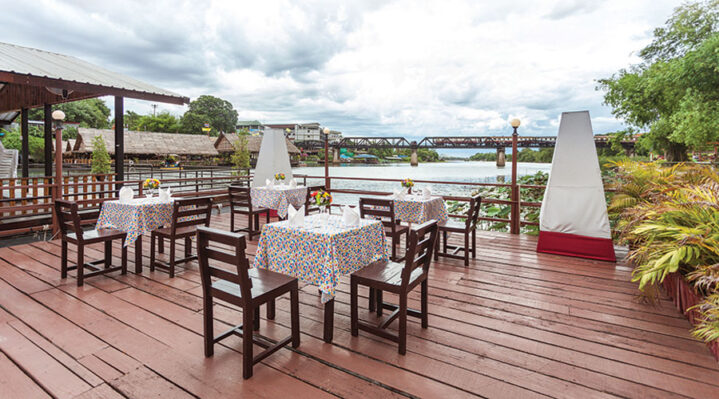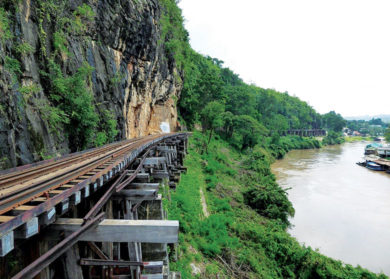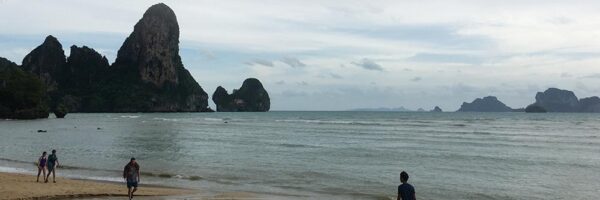
A weekend by the River Kwai
We left Bangkok in rush hour on a Friday evening in congested traffic in the rain. At one point we sat stationary between Thong Lor and Phrom Pong for over 20 minutes and then when we did eventually move an impatient young lady decided to run into the side of my car doing a U turn.
An hour and a half later when police, insurance companies and their investigative agents had been called and explained patiently to the young lady that she was in the wrong and had to accept liability we were finally on our way again. What a perfect start to the weekend.
As a result we did not get to the hotel until just before 10pm tired from the 145kms nearly 3 hour drive up the 323. We had booked into the Felix River Kwai Resort some 500 metres from the world famous bridge.
Exhausted from the long week and tiring drive we showered and fell into bed.
Waking early next morning we walked through the hotel’s pleasant gardens to the dining room and had breakfast. Supplemented we decided to drive into town and get our bearings before the coaches and day trippers arrived.
Touring round we saw Kanchanaburi waking up to a Saturday morning, the locals going about their daily life, opening their shops.
The focal point is obviously the river and the Bridge over the River Kwai. Which is actually a replica of the original bridge after the bridge was attacked and bombed by Allied aircraft built some 5 kilometres from the town on Kanchanaburi.
We have all seen the film, read the book or heard of the dreadful loss of life.
The real history of how the railway between Burma and China was built, including the bridge, is a horrific story. The British didn’t build the railway in the 19th century because it was deemed to be too expensive and an impossible task. During World War II, the invading Japanese took on the project, but expected it to take five years to complete. Those plans were drawn before they found a source of free labour: the Allied POWs. Because of the inhuman amount of labour forced on the prisoners, the railway line that was expected to take five years to complete was ready in only 16 months.
The notorious Burma-Siam railway, built by Commonwealth, Dutch and American prisoners of war, was a Japanese project driven by the need for improved communications to support the large Japanese army in Burma. During its construction, approximately 13,000 prisoners of war died and were buried along the railway.
An estimated 80,000 to 100,000 civilians also died in the course of the project, chiefly forced labour brought from Malaya and the Dutch East Indies, or conscripted in Siam (Thailand) and Burma. Two labour forces, one based in Siam and the other in Burma, worked from opposite ends of the line towards the centre.
Starvation provisions, overloading of work, dismal or absent accommodation and sanitation, and the individual viciousness of Japanese and Korean engineers and guards, took their expected toll. Disease (predominantly dysentery, malaria, beriberi and cholera), brutality (69 men were beaten to death by their guards) and 12 to 18 hour daily work shifts made for a high death rate. In fact, the work went on 24 hours a day with the aid of oil pot lamps and bamboo/wood fires that were kept burning all night long. When looking down on the work area at night it looked like working in the “jaws of hell” – thus the workers gave it the name “Hellfire Pass”.
The city is now a tourist destination for local and international visitors alike. The cemeteries are a solemn reminder of what the city really should be remembered for but the river trips, dinner cruises and disco boats now vying their trade downriver towed by powerful tugboats seem to be one of the key attractions for visitors now.
As we dined by the river directly across from our hotel the train rumbled over the replica bridge 500 metres away and the gaily lit riverboats created a moving vista. We meanwhile dined out on a delicious fare of seafood and river prawns. The busy restaurant was turning over tables quickly with the staff climbing up the stairs with large trays of food and drinks.
Kanchanaburi is the largest of the western provinces and there are other attractions to take in. The Erawan waterfall is known as one of the most pictorial falls in SE Asia and it is 65kms and just over an hour from the city. A further hour away is the Huay Mae Khamin waterfall both located in dense jungle surrounds. there are also a number of caves within an hours drive to the city if you want to go beneath terra firma.
I am told that there are 9, 18 hole golf courses in and around which keep the expats working and living in Thailand happy.
I am pleased to report that the controversial Tiger Temple is now closed, not that I would have endorsed it with a visit anymore than I would ride an elephant. The quicker the authorities rid Thailand of these questionable so called ‘attractions’ and stop exploiting and violating wildlife the better. I feel that same about zoos. I know I would not like to be stuck behind bars in a limited confine for the rest of my life.
The Felix River Kwai Resort is a 4 star resort built on a 130 rai plot of riverfront land. There are 255 rooms with warm wood finishing and private balconies that open out to pretty gardens and or a pleasant view of the River Kwai.
There are two swimming pools, a spa with saunas, a health and massage centre, a fitness centre, tennis courts and a jogging track along the riverside.
It was pleasant to walk alongside the river – it was quiet and had a calming effect on my partner and I and we had a nice weekend that was over too soon. We shall definitely return to explore the region more.




